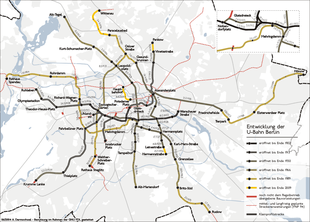This article needs additional citations for verification. (October 2015) |

The Berlin U-Bahn originated in 1880 with Werner Siemens' idea to build an urban railway in Berlin. During the nine years after the German Empire was founded, the city's population grew by over one-third and traffic problems increased. In 1896, Siemens & Halske began to construct the first stretch of overhead railway. On 1 April 1897, the company began construction of an electric underground railway. The Berliner Verkehrs Aktiengesellschaft (BVG) was formed in 1928, and took over further construction and operation of the network. In 1938, the company was renamed Berlin Transport Company; the original acronym, however, remained. Since 1994, the BVG has been a public company.
The line between Stralauer Tor and Potsdamer Platz (the present-day U1 line) was the first to open, on 18 February 1902. Four additional lines were built before the First World War. In the Weimar Republic, hyperinflation initially prevented further expansion of the system. A new line with a wider car, known as Großprofil, opened in 1923.
No stations were built during the Nazi era, and many were destroyed in air raids during the Second World War. Near the end of the Battle of Berlin in early May 1945, the north-south tunnel was demolished and broad sections of the subway flooded; reconstruction of the prewar system lasted until 1950.
Construction of the Berlin Wall in August 1961 introduced restrictions. Lines C (the present-day U6) and D (U8) ran through tunnels and stations in East Berlin without stopping, except for the border crossing at Friedrichstraße station. The Warschauer Straße and Potsdamer Platz stations were decommissioned. Although U-Bahn construction continued in West Berlin, the Line E Tierpark station was the only one to open in East Berlin (in 1973). From 1985 to 1989, Line E (U5) was extended from Tierpark to Hönow.
On 11 November 1989, two days after the fall of the Berlin Wall, the first formerly-closed station (Jannowitzbrücke) was reopened as a border crossing. Rosenthaler Platz followed on 22 December, and Bernauer Straße on 12 April 1990. All three stations are on the U8 line. On 1 July 1990, all remaining ghost stations were reopened. With the reunification of the system, U2 reopened in 1993. In 1995, the U1 was reinstated from Kreuzberg via the Oberbaumbrücke to Friedrichshain at Warschauer Straße station. The U2 Mendelssohn-Bartholdy-Park station opened in October 1998, and a short portion from Vinetastraße to Pankow opened in September 2000. Due to budgetary constraints, there has been no further expansion.
The U-Bahn was built in three major phases:
- Until 1913 – construction of the Kleinprofil ("small profile") network in Berlin, Charlottenburg, Schöneberg, and Wilmersdorf
- 1913–1930 – introduction of the Großprofil ("large profile") network, with the first north–south lines
- After 1953 – postwar development